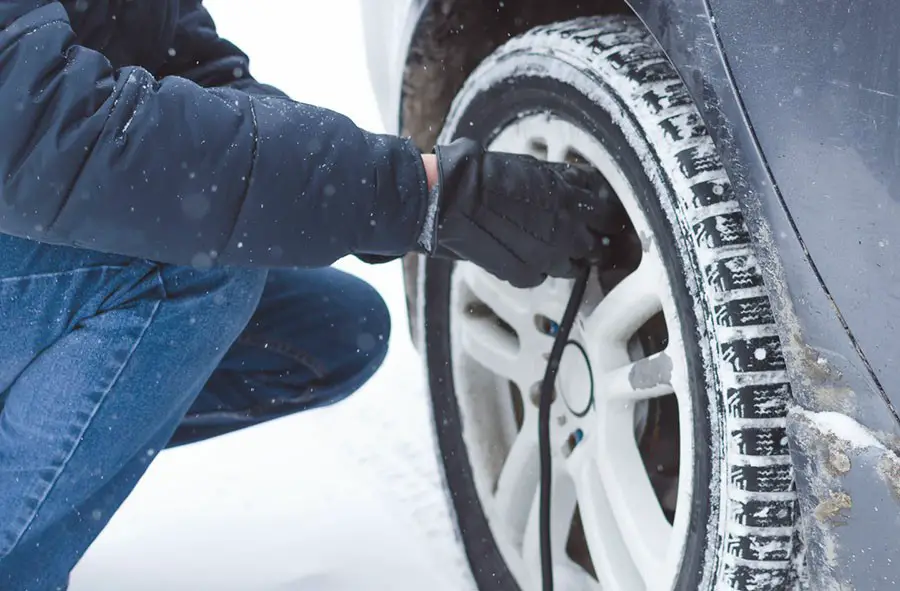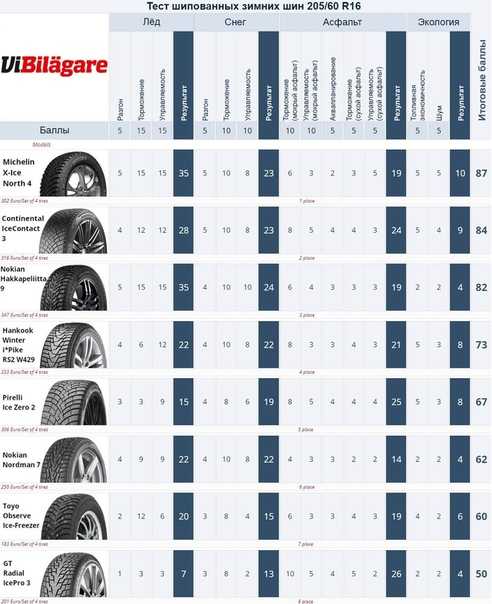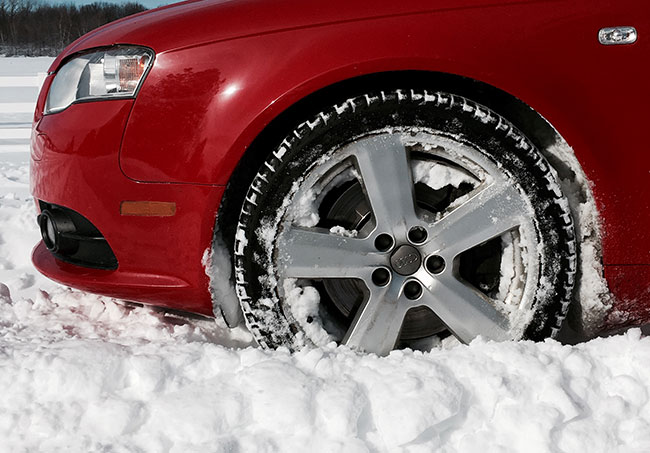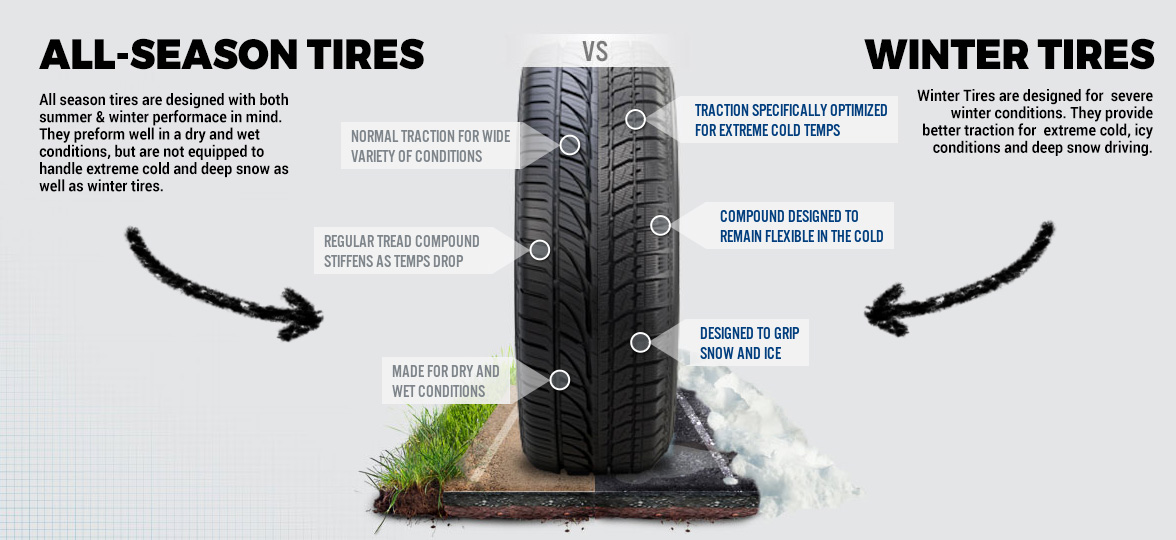When temperatures decrease, tire pressure can drop. It’s reported that with every 10-degree drop in temps, your tire pressure drops 1 pound per square inch (1 PSI).
Yet low tire pressure may require your heavy equipment to use more fuel to get the job done. It can also cause more wear on your tires. So what should tire pressure be in winter?
30 to 35 PSI is generally recommended as the ideal tire pressure for winter temperatures, but the exact recommended pressure varies depending on the type of vehicle and how low the temperature drops.
Ultimately, it’s important to check your vehicle’s owner’s manual and go with the recommended tire pressure provided. Some tires will have ideal PSI listed on the tire sidewalls. Your machine’s recommended tire pressure might also be listed on a sticker inside the driver’s door.
Dropping temperatures might cause a heavy load to need a higher PSI but start with the recommended PSI. Measure the pressure while your tires are cold. Inflate them to that recommended PSI.
Don’t depend on a visual inspection. Use a tire pressure gauge to measure the tire inflation on your heavy equipment to be certain it is sufficient.
The recommended tire pressure for a car is typically between 30 and 35 PSI. For a four-wheel-drive truck, 35 PSI is the norm. Skid steer tire pressure specifications range from 45-60 PSI. Again, check the manufacturer’s manual for optimal tire pressure.
The following table shows variations of tire pressure in cold temperatures:
| Pressure at 68 °F | 30 psi | 40 psi | 60 psi |
| Pressure at 32 °F | 26.9 psi | 36.3 psi | 54.9 psi |
| Pressure at 14 °F | 25.4 psi | 34.4 psi | 52.4 psi |
| Pressure at -4 °F | 23.9 psi | 32.5 psi | 49.8 psi |
Check your equipment’s tire pressure at least weekly during the winter months. Refer to the manufacturer’s manual for recommendations regarding seasonal changes and optimal tire psi.
Refer to the manufacturer’s manual for recommendations regarding seasonal changes and optimal tire psi.
Exceeding the manufacturer’s recommended tire pressure may impact your equipment’s performance and cause premature wear on its tires.
Pneumatic tires, the most used on skid steers, need to be inflated to the proper pressure to function the way they were designed to perform. If at any time you notice your tires sagging after a dip in temperature, measure the PSI of the tires and fill them to capacity.
Underinflating the tire pressure can cause damaging heat and friction on your tires and can cause rubber-compound failure.
Consider switching the standard tires on wheeled power equipment to snow tires to optimize its performance, especially if you’re using it on pavement or for snow removal.
For best performance and to reduce the risk of damaging your equipment, all tires should be switched (not just two), be the same size and brand, and have the same type of tread.
Check the tire pressure on your equipment before you put the machine in operation.
Find a gauge that is designed to measure your type of machinery and adequate PSI range. A gauge with a backlit display will make it easy to check your equipment’s tire pressure at dawn when visibility is low.
Don’t forget to replace the valve caps after checking tire pressure!
Digital gauges are ideal (rather than pen or dial) since they’re easier to use and many come backlit with LED lighting. If you’re starting your shift at dusk, that lighting comes in handy.
There are tire pressure sensor systems available that can be used on different types of heavy-duty vehicles, from F150 trucks to large skid steers. Check the literature that comes with these tool kits to ensure one can be used on your machine and still provide you with sufficient tire pressure data.
Eagle Power & Equipment has factory-trained technicians on staff to help you, as well as access to engineers and the factory. We offer on-site field repair and, specifically, tire repair so we encourage you to stop by or call to learn more about our services and repairs.
We offer on-site field repair and, specifically, tire repair so we encourage you to stop by or call to learn more about our services and repairs.
Posted in Heavy Equipment Safety, News, Skid Steer and tagged heavy equipment, pneumatic tires, power equipment, recommended tire pressure, skid steers, tire pressure on by Eagle Power.
Yes, you typically need to inflate your tires in cold weather. As we'll explain, low temperatures often mean low tire pressure, and low tire pressure could mean dangerous driving conditions.
With the promise of holiday travel up ahead, it’s time to prepare! Firestone Complete Auto Care is here to help you drive safer with a quick lesson on cold weather and tire pressure.
First, a quick science lesson: when the temperature drops, molecules in the air move slower and huddle together. When the temperature increases, molecules move faster and farther away from one another!
When the temperature increases, molecules move faster and farther away from one another!
You can test this concept for yourself. Just set a basketball outside and wait! The ball will slightly deflate in the cold morning air, then re-inflate in the heat of the afternoon.
When this concept plays out inside your tires, it can affect your tire pressure.
That's because tires lose or gain 1-2 PSI (pounds per square inch) for every 10℉ change in temperature. So theoretically, your tires could lose 4 PSI over the weekend if the temperature drops by 20℉!
While your tire pressure should bounce back after the cold spell passes (assuming it does pass and your tires have no leaks or holes), low tire pressure shouldn't be ignored.
Low tire pressure can lead to:
 2% for every 1 PSI drop in the average pressure of all tires, notes the U.S. Department of Energy.
2% for every 1 PSI drop in the average pressure of all tires, notes the U.S. Department of Energy.A small decrease in tire pressure is hard for the naked eye to detect, but it can still have a big impact on your driving. Tires can lose pressure even when temperatures remain constant over the winter. To be safe, we recommend checking tire pressure every other time you visit the pump, and especially when your TPMS light pops on.
Here’s how:
You can find it written in your owner’s manual or on a sticker attached to your door jamb, glove box, or fuel hatch. Recommended tire pressure usually falls between 30-35 PSI for passenger cars. If you’re not sure, try our recommended tire pressure tool.
 Check your tires before driving.
Check your tires before driving.Measure your tire pressure before driving, not after, for the most accurate reading. This practice is referred to as setting the cold tire pressure. If your recommended tire pressure is 32 PSI, that means 32 PSI before you put rubber to the road and the tires heat up.
Tire pressure gauges can be purchased for a few dollars at most big box retailers. "Pencil" style gauges are cheapest and have a little stick that pops out with the tire pressure reading. Digital tire pressure gauges are a bit more expensive but are extremely easy to use.
This is the little black, blue, green or silver screw-cap on your wheel's valve stem. It should be plainly visible from the outside of your car.
Follow the instructions that come with your tire pressure gauge. If there's a hissing sound when you insert the gauge, it may not be properly seated on the valve stem. Re-adjust the angle of the gauge until the hissing stops. What's your tire pressure? Do your tires need to be inflated?
Re-adjust the angle of the gauge until the hissing stops. What's your tire pressure? Do your tires need to be inflated?
Repeat the process for each tire and note your tire pressure readings.
There's a good chance you'll need to inflate your tires in winter at least once. If your tire pressure is low, find your nearest air pump. Add air until you reach your recommended tire pressure, or visit your nearest Firestone Complete Auto Care and we'll inflate your tires for you.
If you need help with any of these steps, please don't hesitate to stop by a local Firestone Complete Auto Care. Summer or winter, sunshine or snow—our knowledgeable technicians will check the health of your tires, inflate them to the recommended pressure, and guide you in buying new tires if yours show an alarming degree of wear.
In the topic “wheels in winter”, the focus is usually on the tires themselves: the choice between expensive and cheap, studded and Velcro. The question of how to inflate them is taken for granted, and, as the AvtoVzglyad portal found out, in vain ...
The question of how to inflate them is taken for granted, and, as the AvtoVzglyad portal found out, in vain ...
Maxim Stroker
In winter, even in such a simple action as inflating wheels, a number of not very obvious nuances appear. They are connected, in fact, with the fact that frost rages on the street. The fact is that, as you know, all substances shrink and decrease in volume when cooled, and expand when heated. Moreover, gases are especially susceptible to this effect. The air with which we pump up the wheels is also a gas. Rather, it is a mixture of gases, but this is not important in this case.
So, based on the experience of operating machines, it is empirically deduced that for every 8 ° C decrease in the temperature outside, the pressure in the wheel drops by 0.1 bar (10 kPa, 0.1 atmosphere). Thus, if at + 20ºС the wheel is pumped up to 2.4 atmospheres, then when it cools (well, let's say this, purely theoretically!) To -20ºС, the pressure in it will drop to 1. 9 atmospheres. That is - almost 20% lower than recommended in the "manuals" of many automakers.
9 atmospheres. That is - almost 20% lower than recommended in the "manuals" of many automakers.
It is a mistake to think that such a situation is possible only in an inflamed journalistic imagination! Imagine a typical autumn situation: you came to the tire shop to “change shoes” - change tires from summer to winter. As is often the case in small workshops, the wheels are pumped up to the required 2.2-2.4 atmospheres immediately after balancing - in a warm room at a temperature of about + 20ºС.
In a short time, normal winter cold sets in - albeit not with 20-degree frosts, but with a confident "minus" of about -10ºС. The pressure drop in this case will be about 0.4 atmospheres, which is also significant. If you do not pay due attention to this moment, it will turn out that the car will then drive for almost the whole winter on flat tires. Someone will say that this is even good - they say, cross-country ability is improving.
Yes, but only in one case - when driving on soft loose snow, when an increase in the contact patch between the wheel and the road allows the car to fall into soft snow less. If, like the vast majority of cars, in winter we drive mainly on hard-surface roads that are more or less cleared of snow, flat tires will only induce.
If, like the vast majority of cars, in winter we drive mainly on hard-surface roads that are more or less cleared of snow, flat tires will only induce.
Because of them, controllability will noticeably worsen, the car will slip into side slip more easily, brake worse, fuel consumption will increase, etc. The conclusion from the above is as follows. When “re-shoeing” a car into winter tires, you should always pump the wheels at least 0.2 atmospheres higher than recommended. So we compensate for the pressure drop in them due to the cold.
But you should not exceed this level too much. After all, while driving, even in the most severe cold, the tires heat up and the pressure in them sometimes rises by 0.2–0.3 atmospheres, partially leveling the winter “thinning” of tires.
We understand how a car from Wolfsburg has turned into a competitor BMW X5
36010
We versed a car from Wolfsburg.
36010
0009
Please enable JavaScript in your browser to display pages properly.
8 (800) 707-65-40
Request a call
Remind password
Personal account
New customer
1 + 2 =I hereby confirm that I have read and agree to the terms of the privacy policy and consent to the processing of my personal data. Learn more
Request a call
Leave your phone number and a convenient time to call, and we will call you back
Shopul. Komsomolskoye highway, 3b st. Business, 7st. Vaneeva, 209Aul. Golubeva, 7 st. Karl Marx, 60 vul. Comintern, 39, room 1st. Generala Ivlieva, house 24Aul. Fuchik, 36, Perekhodnikova st., 28/1 st. Dyakonova, 2 r. Gaugelya 2A/2pr. Gagarina, 37b 5 + 7 =
Dyakonova, 2 r. Gaugelya 2A/2pr. Gagarina, 37b 5 + 7 = I hereby confirm that I have read and agree to the terms of the privacy policy and consent to the processing of my personal data. Learn more
The air compression in a car wheel is indicated in atmospheres. The recommended tire pressure value should be indicated in the technical documentation for the car, on the signs on the gas tank hatch or next to the driver's seat. If the readings were not in these places, then you should contact the center where the car was purchased. It is not necessary to focus on the markings indicated on the surface of tires, because the pressure depends on the mass of a particular vehicle.
In the cold season, the air compression characteristic in car tires is recommended within 2-2.2 Atmospheres.
Not all drivers pay due attention to this characteristic, but it is of great importance for various indicators:

There are recommendations for an external inspection of tires before the start of each trip, before starting the engine. The level of air compression should be monitored every two weeks with a pressure gauge. This device is embedded in most modern compressors, which are connected either to the cigarette lighter in the car or to the battery terminals.
To correctly control the level of pressure in tires, you must adhere to the following rules:
